- Home
- Things to Do in Sicily
- Mount Etna
Mount Etna Hiking: A Guide to Sicily's Sacred Volcano
As we stand before the great mountain—Europe's tallest active volcano, a colossus of fire and stone that rises 3,350 meters (10,000 feet) above the Ionian Sea—we feel the ancient pull, that primordial summons to ascend.
Mount Etna hiking offers not merely recreation but communion with forces that shaped civilizations, a passage through landscapes where mythology and geology converge in sublime, terrible beauty.
The volcano breathes still, exhaling sulfurous plumes that drift across blackened slopes, reminding us that we walk upon a living entity, capricious and eternal.
To climb to Mount Etna hiking trails is to trace the footsteps of Greek philosophers and Norman knights - as well as WW2 soldiers - to witness creation and destruction locked in their perpetual dance. Are you prepared to answer the mountain's call?
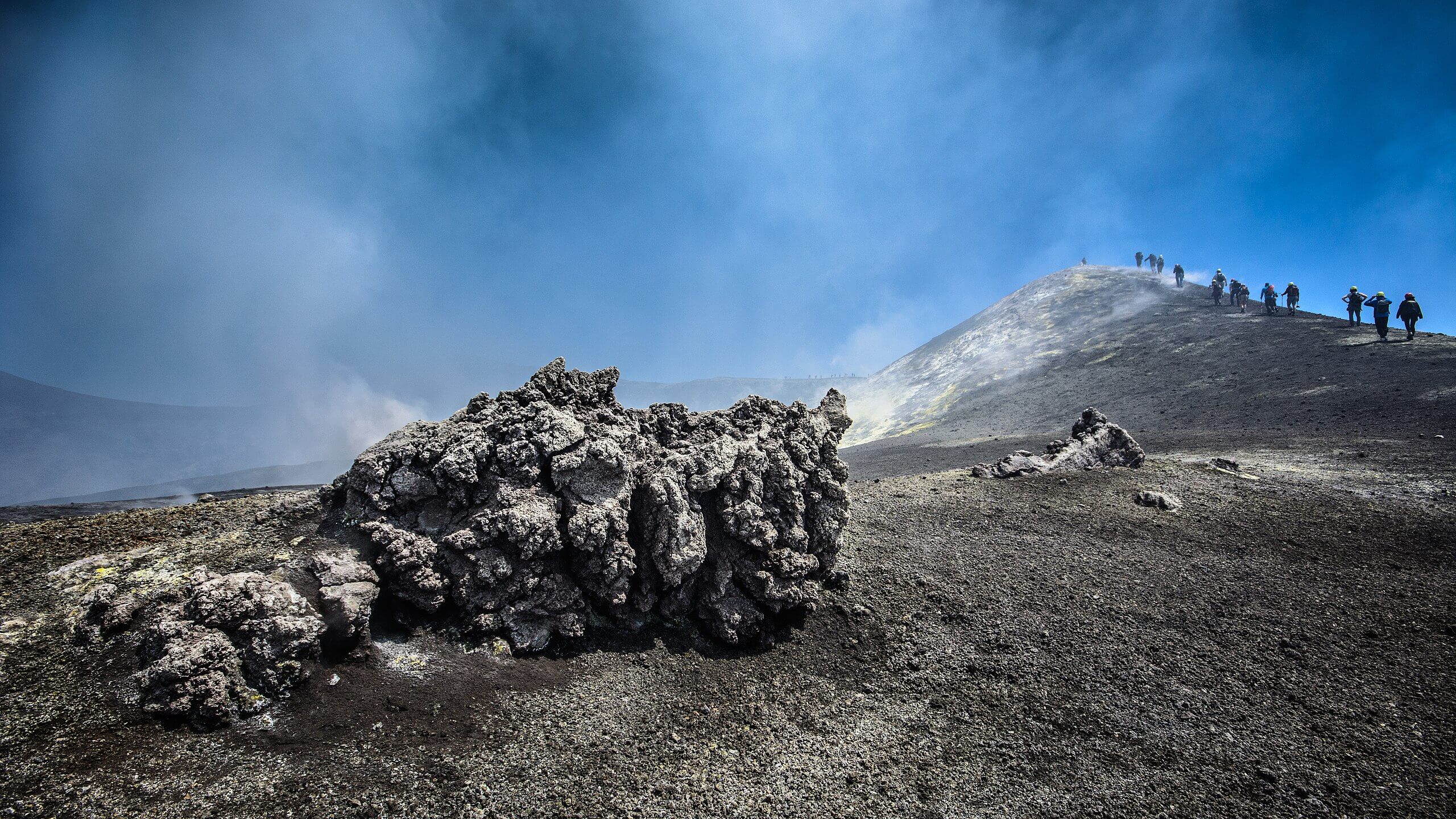 Lunar landscapes on the Mount Etna hiking trip. (Wikimedia Commons/kuhnmi)
Lunar landscapes on the Mount Etna hiking trip. (Wikimedia Commons/kuhnmi)Mount Etna Hiking
The volcano dominates eastern Sicily with a presence both nurturing and menacing, its fertile lower slopes cloaked in vineyards and orchards that yield wines of volcanic minerality and fruits of uncommon sweetness.
You can approach it from any of the neighboring towns, the biggest of which is Catania. This baroque city has risen phoenix-like from Etna's ashes seventeen times. Its buildings are constructed from the very lava that destroyed them.
The mountain reveals itself gradually as you ascend the winding SP92 road, first as a distant cone wreathed in cloud, then as an overwhelming mass that fills the windscreen and dwarfs the human scale.
Villages cling to its flanks like barnacles to a ship's hull: Nicolosi, Zafferana Etnea, Linguaglossa—each a potential threshold to the wilderness above.
The air grows thinner, cooler; pine forests give way to lunar desolation.
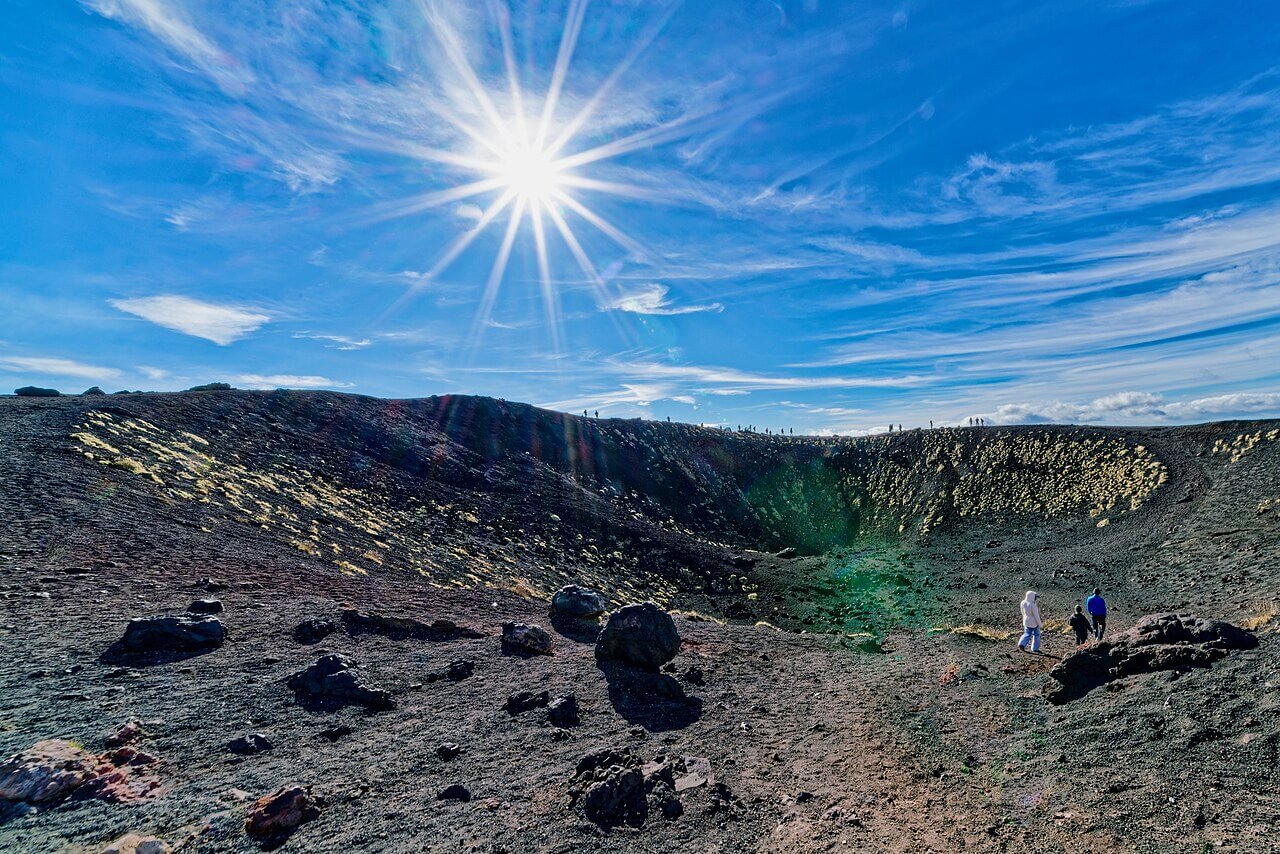 If you don't feel like climbing to the top, there are plenty of sights to see from the lower craters. You can get right up close by bus. (Wikimedia Commons/Holger Uwe Schmitt)
If you don't feel like climbing to the top, there are plenty of sights to see from the lower craters. You can get right up close by bus. (Wikimedia Commons/Holger Uwe Schmitt)Mount Etna Hiking Trails
Mount Etna hiking trails span a remarkable altitudinal and ecological gradient, from the verdant Piano Provenzana at 1,800 meters on the northern flank to the desolate summit craters that scrape the sky above 3,300 meters.
One must choose one's path according to fitness, ambition, and the volcano's current temperament, for Etna is no passive monument but an active forge that periodically closes routes and reshapes the terrain with fresh eruptions.
The southern approach via Rifugio Sapienza offers the most accessible ascent, with the cable car—a mechanical marvel that hoists pilgrims 2,500 meters in 15 minutes—providing swift passage through the montane zone to the edge of the volcanic desert.
From there, authorized guides lead groups in rugged four-wheel-drive vehicles to 2,900 meters, leaving only 400 vertical meters to be conquered on foot. Yet this convenience exacts a price: the route teems with tourists, and the sacred solitude of high places remains elusive.
Consider instead the northern trails from Piano Provenzana, where you walk the entire distance, earning each meter through exertion and will.
The path winds through the haunting relics of the 2002 eruption—twisted ski-lift pylons, half-buried buildings, forests of dead pines standing like charred sentinels—a memento mori carved in basalt and ash.
The trail steepens beyond the tree line, switchbacking across cinder fields where each step sinks ankle-deep into volcanic scoria, the porous fragments of exploded magma that crunch and hiss beneath the boots.
The climb takes four to six hours, depending on pace and pauses, the summit craters gradually resolving from abstract shapes into vast, smoking amphitheaters rimmed with sulfur-yellow fumaroles.
This route demands more: stronger legs, stouter hearts, and an acceptance of solitude and effort. But the rewards are commensurate—a genuine encounter with the mountain's austere majesty, unmediated by machinery or crowds.
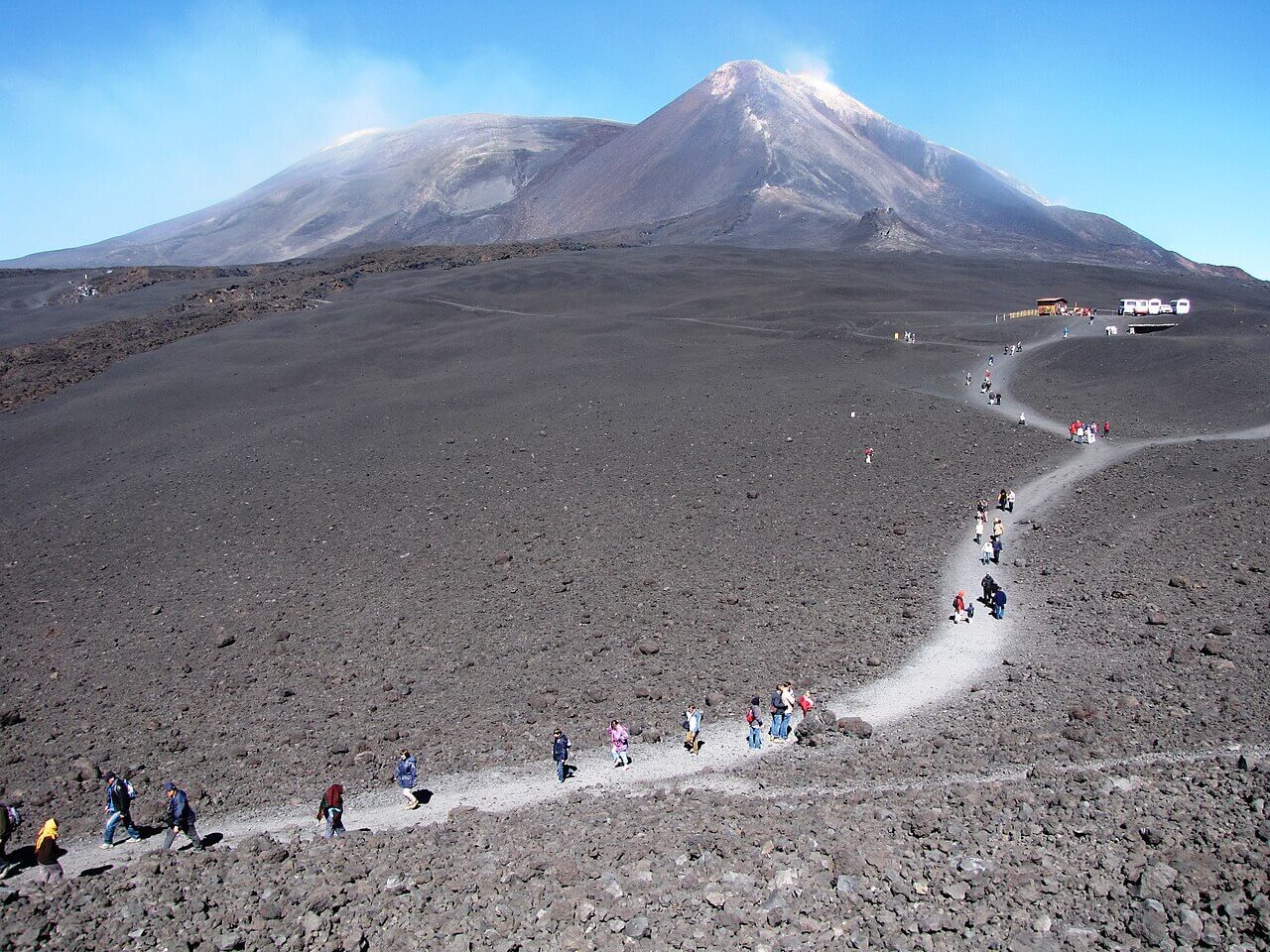 Mount Etna hiking party. (Wikimedia Commons/Hein56didden)
Mount Etna hiking party. (Wikimedia Commons/Hein56didden)When to Go?
It is important to consider the time of the year when going to Mount Etna hiking trip. The volcano's moods shift with the seasons, each offering distinct revelations and challenges to those who would ascend its flanks.
Spring
Spring arrives late on Etna's heights, where snow lingers in shadowed gullies until May and wildflowers—Etna violets, milk-vetch, Sicilian ragwort—embroider the volcanic soil with improbable color.
The hike lingers through landscapes of stark contrast: black lava flows still warm from recent eruptions, green shoots of Etna broom thrusting through cracks in century-old pahoehoe, the ropy, frozen waves of basaltic glass.
The air carries the scent of wild fennel and thyme, mingled with the acrid tang of sulfur dioxide that seeps from countless vents and fissures.
Temperatures at the summit hover near freezing even as the coast below basks in Mediterranean warmth; better to layer with merino and Gore-Tex, prepared for microclimates that change with altitude and exposure.
Spring hiking offers moderate crowds and the spectacle of Etna awakening from winter dormancy, its slopes alive with birdsong and the distant rumble of subterranean forces stirring.
Summer
Summer transforms the volcano into a realm of extremes: the lower slopes shimmer with heat. At the same time, the summit remains a windswept fastness where temperatures rarely exceed fifteen degrees Celsius.
The ascent starts in pre-dawn darkness to avoid the punishing midday sun that turns the black lava into a heat-radiating griddle, sapping strength and will.
Autumn
Autumn cloaks Etna in melancholy grandeur, the season when the mountain seems most itself—brooding, introspective, touched by the intimation of winter's approach.
The tourist hordes thin; the walk goes through landscapes painted in ochre, rust, and charcoal in relative solitude.
The Mount Etna vineyards below us blaze with autumn color, their leaves turning crimson and gold as harvest approaches, the grapes swollen with the concentrated sugars that will become Etna Rosso and Etna Bianco, wines that taste of volcanic soil and ancient sunlight.
It is possible to visit these vineyards too, but it's better to do so on another day. Unless you are in a hurry. Then the best option is to find a tour organization that offers combined tours. Alone, it might get too tedious. Lots of winding roads, lots of changing variables...
Clouds gather on the mountain slopes around the year. Even more so in autumn. That's why it's crucial to start the journey early. (The guided tours that can take you to the top all start before midday around the year anyway.)
Winter
Winter hiking on Etna is the province of the experienced and the audacious, for the mountain dons its most forbidding aspect when snow blankets the slopes and ice glazes the trails.
Crampons, ice axes, and avalanche awareness are required. And a guide who knows the mountain's winter moods and hidden dangers.
The contrast between fire and ice becomes visceral as one encounters warm ground—patches where geothermal heat melts the snow, revealing black rock steaming in the frigid air —a reminder that beneath our feet, magma churns at temperatures exceeding 1,000 degrees Celsius.
It is better to anchor the pilgrimage to the volcano with practical considerations. This way, one can transform romantic aspirations into an achievable reality through careful planning and preparation.
 Mount Etna in winter. (Wikimedia Commons/Josep Renalias)
Mount Etna in winter. (Wikimedia Commons/Josep Renalias)How to Get There
You reach Etna's trailheads by car or with a bus from Catania, the journey taking 60 to 90 minutes, depending on your chosen route and the capriciousness of Sicilian traffic.
The AST bus company operates seasonal routes from Catania to Rifugio Sapienza on the south side, departing in the morning and returning late afternoon—a serviceable option for those without vehicles. However, the schedule constrains our time on the mountain.
Renting a car grants freedom and flexibility, allowing one to explore multiple trailheads and linger at viewpoints. That same car can take you to the Mount Etna vineyards that terrace the lower slopes, where we might taste the terroir of volcanic soil in a glass of Nerello Mascalese.
The roads are good, if winding; you'll navigate switchbacks that climb through ecological zones with dizzying rapidity, each turn revealing new vistas of coast, countryside, and the ever-present mountain.
Parking at Rifugio Sapienza costs approximately 5 euros; Piano Provenzana offers free parking, but it fills up quickly in summer.
Guided Tours to Mount Etna
Guided ascents provide safety, interpretation, and legal access to the highest zones, which are restricted without authorization due to volcanic hazards and the need to protect fragile ecosystems.
Better yet to engage certified guides through established operators—Etna People, Guide Vulcanologiche Etna, Gruppo Guide Alpine Etna—who provide helmets, headlamps for pre-dawn starts, and the reassurance of expertise accumulated through hundreds of ascents.
A typical guided summit hike costs 70 to 100 euros per person, including cable car and off-road vehicle transport on the southern route; full-day treks from Piano Provenzana run slightly less, as they eschew mechanical assistance.
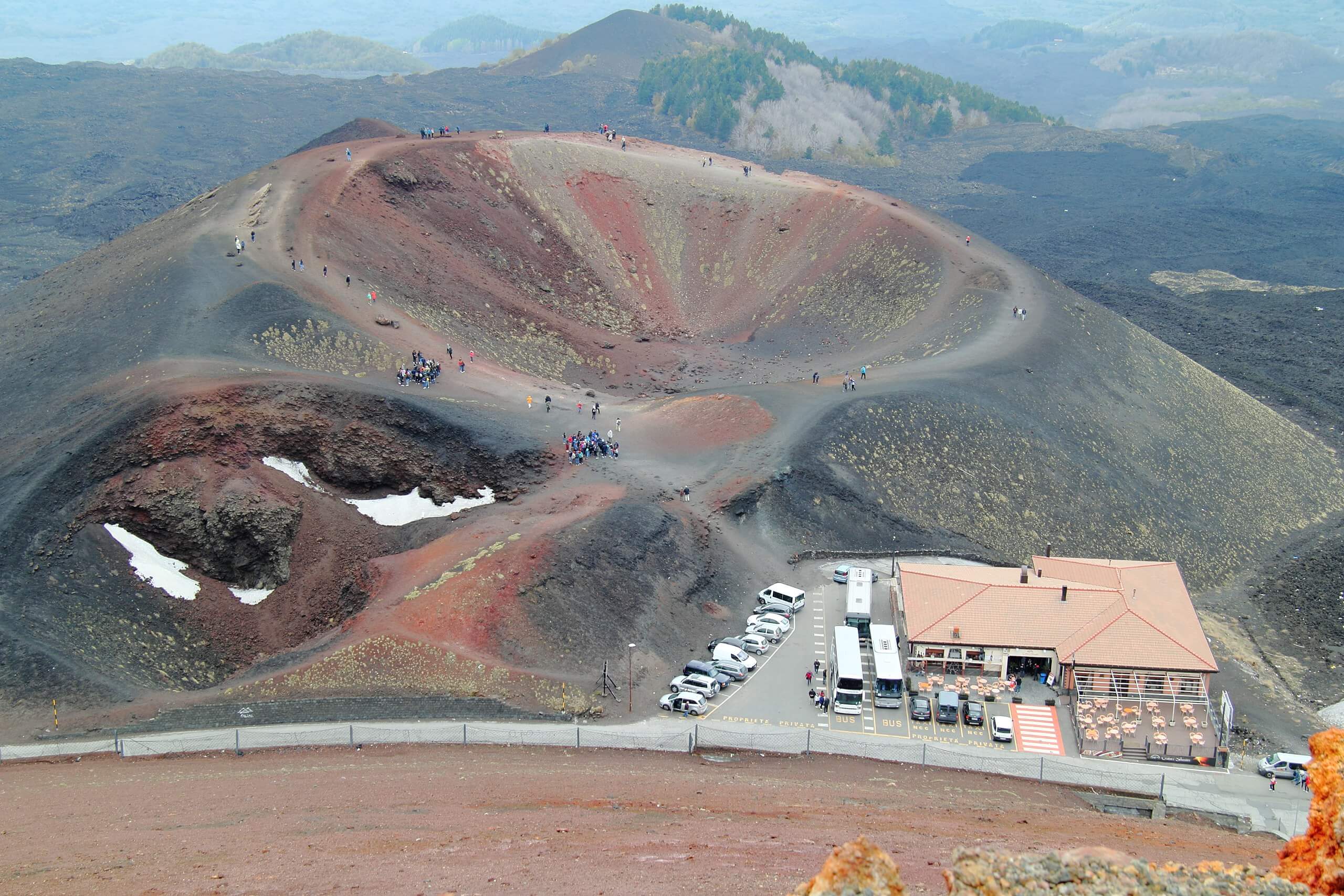 Rifugio Sapienza. Whether you come by bus or by car, you'll first end up here. You can get higher up by taking the travel agency's jeep or cable car. However, it's pretty pointless to go there unless you're prepared to pay the tour operator - it is forbidden to proceed alone from the cable car's upper station. (Wikimedia Commons/Sabe!)
Rifugio Sapienza. Whether you come by bus or by car, you'll first end up here. You can get higher up by taking the travel agency's jeep or cable car. However, it's pretty pointless to go there unless you're prepared to pay the tour operator - it is forbidden to proceed alone from the cable car's upper station. (Wikimedia Commons/Sabe!)What to Wear
The equipment must match the mountain's demands: sturdy hiking boots with ankle support and aggressive tread to grip loose scoria; layered clothing to accommodate temperature swings of twenty degrees or more between base and summit; sun protection—hat, sunglasses, high-SPF sunscreen—for the intense UV radiation at altitude, unfiltered by the thin atmosphere.
Carry water—at least 2 liters per person—for there are no sources on the upper mountain; only the sulfurous condensation from fumaroles, undrinkable and foul.
Energy-dense snacks—nuts, dried fruit, chocolate—can help sustain through the calorie-burning ascent.
A windproof jacket is essential; even in summer, summit winds can gust to 50 kilometers per hour, driving the wind chill below freezing.
Trekking poles ease the strain on knees during the descent, when the loose volcanic gravel threatens to send us sliding and stumbling.
A headlamp is necessary for pre-dawn starts or for lingering past dusk, watching the sunset paint the Ionian Sea in shades of copper and violet. If you are with a tour operator, they might provide these.
Vineyards on the Slopes of Etna
Another possibility is to conclude your pilgrimage not at the trailhead but in the Mount Etna vineyards that encircle the volcano's base, where you can taste the mountain's essence transformed into wine.
The vines grow in alberello—small bush form—their roots delving deep into volcanic soil rich in minerals and poor in organic matter, producing grapes of intense concentration and distinctive character.
The secret to Etna's wines lies in the cool climate and soil. The cool air slows the grapes' ripening, and the soil gives them a distinctive volcanic flavor.
On Etna, the vineyards are located on the northern and eastern slopes. The north has better views and fewer tourists. There are also more driving distances.
Better book a visit to the vineyards in advance.
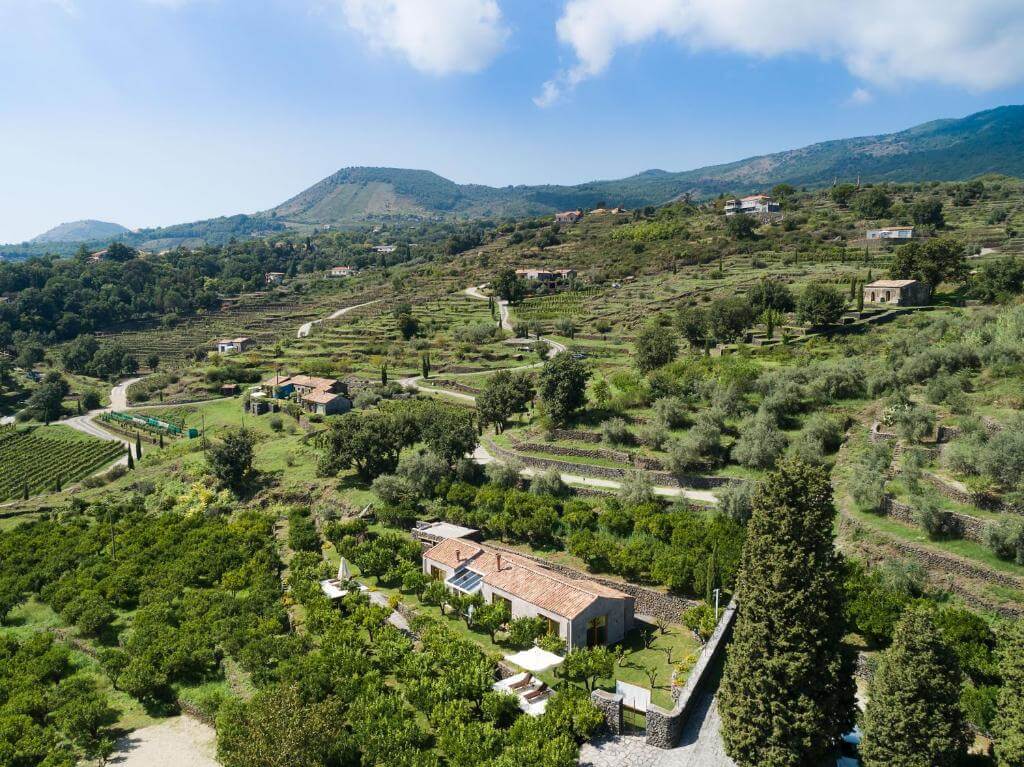 Combining local food and wine with a luxurious countryside vacation is possible in places like Monaci delle Terre Nere.
Combining local food and wine with a luxurious countryside vacation is possible in places like Monaci delle Terre Nere.Conclusion
Mount Etna—three thousand meters of basalt throne rising from the Ionian plain—the slow, inexorable crush of lava, the sudden exhalation of pyroclastic breath, and yet, impossibly, the persistence of life.
Chestnut groves cling to cooled magma; vines twist through volcanic soil; the ecosystem endures, resilient and strange, a testament to nature's capacity for both destruction and regeneration.
The region surrounding this colossus holds history in its fists: processions wind through medieval streets; bread is broken according to formulae older than memory; every stone, every song, every gesture of hospitality bears the mark of Etna's long and watchful presence.
Come, then, whether you seek the ordeal of ascent, the communion of shared bread and wine, or simply the chance to stand—small, mortal, in awe—before this volcanic leviathan.
We promise you this: the mountain will meet your expectations, exceed them, and leave you changed.
(November 5, 2025)
Recent Articles
-
Honeymoon in Sicily: Where Landscapes Stir the Heart
Dec 17, 25 12:21 PM
Honeymoon in Sicily: Timeless temples, coastal hideaways, slow meals, and landscapes that invite closeness. -
Best Time to Visit Sicily: Your Seasonal Guide
Dec 05, 25 04:23 AM
Find the best time to visit Sicily. Explore seasonal weather, crowds, prices, and highlights. -
Where to Stay in Sicily: Top Areas for Every Traveler
Nov 27, 25 08:14 AM
Where to stay in Sicily: A guide to the island’s best regions, helping you choose the perfect base for your trip.
Follow MANY FACES OF SICILY on Facebook, Instagram, Bluesky & Tumblr
Contact: vesa@manyfacesofsicily.com







